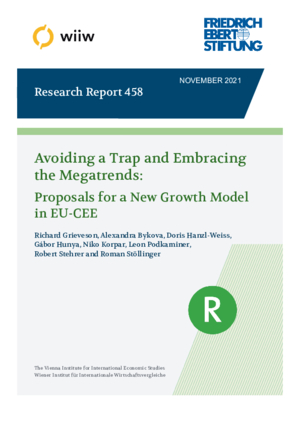Avoiding a Trap and Embracing the Megatrends: Proposals for a New Growth Model in EU-CEE
Alexandra Bykova, Richard Grieveson, Doris Hanzl-Weiss, Gabor Hunya, Niko Korpar, Leon Podkaminer, Robert Stehrer and Roman Stöllinger
wiiw Research Report No. 458, November 2021
89 pages including 6 Table and 26 Figures
It is now over three decades since the eleven EU member states in Central, Eastern, and Southeastern Europe (EU-CEE) started their transition to market capitalism. All countries experienced deep recessions in the early 1990s, but since have achieved mostly sustained convergence with Western Europe. Many EU CEE countries have overtaken Southern EU member states in terms of economic development. However, growth rates have slowed since the 2008 crisis, and the level of economic and social development varies widely across the region. This study has three key components. First, it establishes that the existing EU-CEE growth model may be reaching its limit, especially for the region’s most developed countries. Second, it details the megatrends which will further impact the region’s growth model now and in the future, including demographic, environmental, and digital factors. Finally, it outlines a set of policy options to develop the region’s growth model in a way that would drive a more sustained and sustainable rate of convergence with Western Europe in the coming decades. We find that governments in the region need to a) provide an underlying infrastructure that can support the growth of internationally competitive companies, b) fully embrace and take advantage of the digital revolution, c) maximise all available resources to profit from the green transition, and d) use policy levers to stimulate the automation of low productivity jobs and ease the transition into new and higher value work for their populations. Behind this should stand two important supportive pillars: accommodative fiscal and monetary policy at the national and EU levels and a more progressive tax system to fund an expanded welfare state.
Keywords: EU-CEE, transition, convergence, functional specialisation, digitalisation, green transition, EU, demographics, FDI, industrial policy
JEL classification: O40, O47, P27, F21, O44, L16
Countries covered: Bulgaria, Croatia, Czechia, Estonia, EU-CEE, Hungary, Latvia, Lithuania, Poland, Romania, Slovakia, Slovenia
Research Areas: Macroeconomic Analysis and Policy, International Trade, Competitiveness and FDI
